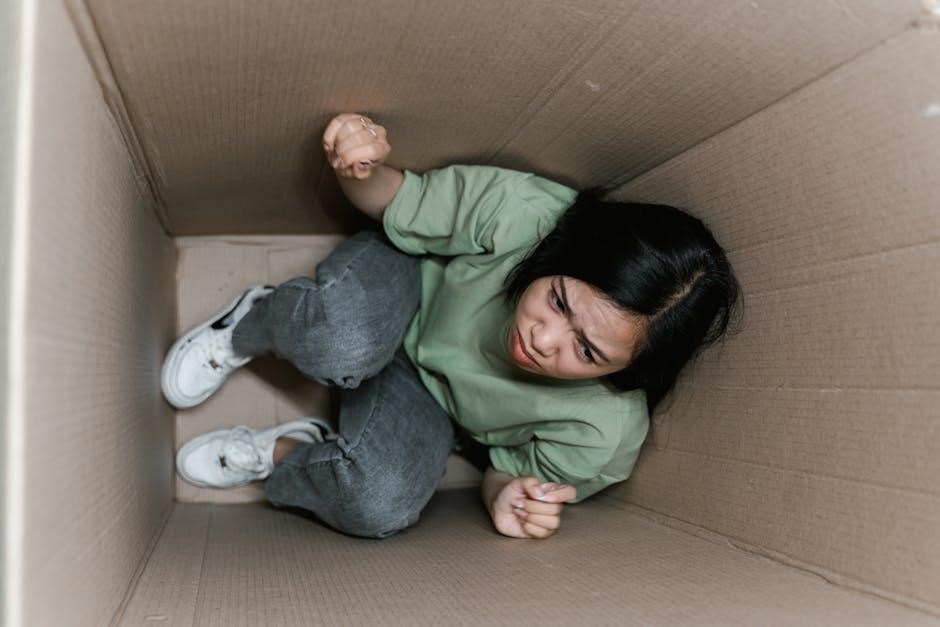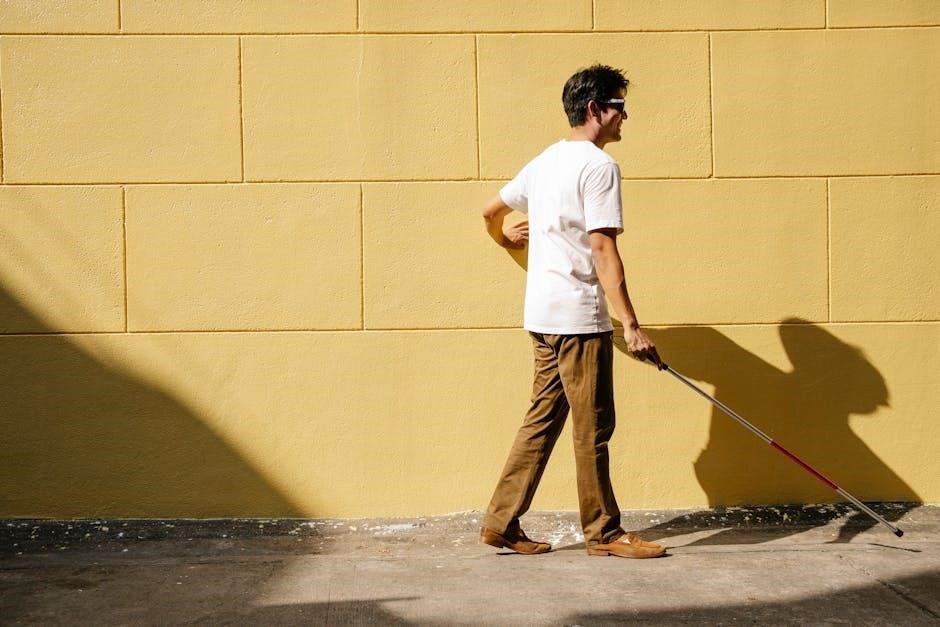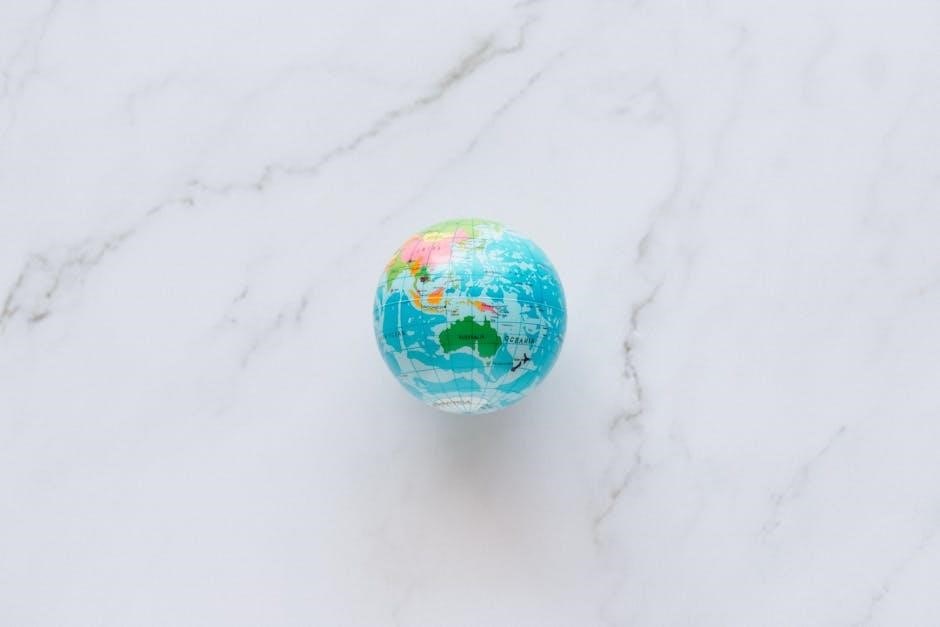Internalized homophobia is a profound struggle, often rooted in societal norms and self-hatred․ It manifests as shame, self-doubt, and emotional pain, hindering self-acceptance and mental well-being․ Understanding its origins and impact is crucial for healing and embracing authenticity․
Defining Internalized Homophobia
Internalized homophobia refers to the unconscious absorption of societal homophobic attitudes, leading individuals to harbor self-hatred, shame, and rejection of their own sexual orientation․ It arises when individuals internalize the prejudiced views prevalent in their environment, often manifesting as self-loathing, denial, or difficulty accepting their identity․ This psychological conflict can stem from religious, cultural, or familial influences that condemn homosexuality, causing individuals to struggle with their natural feelings․ Internalized homophobia is distinct from external homophobia, as it resides within the individual, often resulting in emotional turmoil, mental health challenges, and strained relationships․ Recognizing this internalized prejudice is the first step toward healing and self-acceptance․
The Impact of Societal Homophobia on Individuals
Societal homophobia profoundly shapes how individuals perceive themselves, often fostering internalized shame and self-doubt․ When surrounded by discriminatory norms, LGBTQ+ individuals may struggle to embrace their identity, leading to emotional distress and mental health challenges․ The constant exposure to prejudice can result in feelings of inadequacy, anxiety, and depression․ Many individuals internalize these negative messages, doubting their worth and questioning their sexual orientation․ This societal influence can also lead to strained relationships, as fear of rejection and judgment isolates individuals from their communities․ The psychological toll of societal homophobia is significant, often manifesting as self-hatred and a deep-seated conflict with one’s true self․
The Role of Shame and Self-Hatred in Internalized Homophobia
Internalized homophobia often manifests as deep-seated shame and self-hatred, rooted in societal prejudices against LGBTQ+ individuals․ This emotional burden leads to negative self-perceptions, self-doubt, and a distorted sense of self-worth․ Shame can foster self-destructive behaviors, such as substance abuse or self-sabotage, as individuals struggle to reconcile their true identity with societal expectations․ Self-hatred may also express as self-loathing or a rejection of one’s sexual orientation, further alienating individuals from their authentic selves․ These feelings can severely impact mental health, creating a cycle of emotional pain that interferes with personal growth and relationships․ Addressing shame and self-hatred is essential for healing and self-acceptance․

Understanding the Roots of Internalized Homophobia
Internalized homophobia stems from societal norms, family upbringing, and personal trauma, fostering self-hatred and emotional pain․ These influences shape negative self-perceptions and hinder self-acceptance, complicating the journey toward authenticity․
Societal Influences and Media Representation
Societal norms and media representation play a significant role in shaping internalized homophobia․ Negative stereotypes and lack of diverse representation in media often perpetuate harmful beliefs about LGBTQ+ individuals․ Growing up in environments where same-sex attraction is stigmatized or erased can lead to feelings of inadequacy and self-loathing․ Media that portrays LGBTQ+ people as inferior or abnormal reinforces these harmful narratives, making it difficult for individuals to embrace their true selves․ The constant exposure to homophobic messages can internalize shame, fostering a deep-seated fear of rejection and a struggle to accept one’s sexual orientation․ Addressing these societal influences is key to overcoming internalized homophobia․
The Role of Family and Upbringing
Family and upbringing significantly influence the development of internalized homophobia․ Growing up in an environment where homophobic beliefs are prevalent can lead to the internalization of negative messages about one’s sexuality․ When family members express disapproval or rejection, it often results in self-hatred and shame․ Even subtle behaviors, such as dismissive comments or lack of support, can deeply impact an individual’s ability to accept themselves․ This upbringing fosters fear of rejection and self-doubt, making it challenging to embrace one’s true identity; Understanding the role of family dynamics is crucial for addressing and overcoming internalized homophobia, as it often requires healing from these early experiences and relearning self-compassion and acceptance․
Religious and Cultural Beliefs
Religious and cultural beliefs often play a significant role in shaping internalized homophobia․ Many individuals grow up in environments where religious teachings or cultural norms explicitly condemn homosexuality, leading to feelings of guilt and shame․ These beliefs are deeply internalized, fostering self-hatred and self-rejection․ For example, interpretations of religious texts that view same-sex attraction as immoral can create a profound sense of conflict between one’s faith and sexual identity․ Cultural expectations of heteronormativity further exacerbate this struggle, making it difficult for individuals to reconcile their true selves with societal and religious demands․ Addressing these influences is essential for healing and self-acceptance․
Personal Trauma and Negative Experiences
Personal trauma and negative experiences significantly contribute to internalized homophobia․ Experiences such as bullying, rejection, or verbal abuse due to one’s sexual orientation can deeply embed feelings of shame and self-hatred․ For many, these traumatic events occur during formative years, leaving lasting emotional scars․ Negative interactions with family members, peers, or authority figures can reinforce harmful beliefs about being LGBTQ+․ Such experiences often lead to self-rejection and a struggle to accept one’s identity․Trauma can also manifest as fear of intimacy or hypervigilance in relationships, further complicating self-acceptance․ Addressing these wounds is a critical step in overcoming internalized homophobia and fostering self-compassion․

Recognizing the Signs of Internalized Homophobia
Common signs include self-loathing, difficulty accepting one’s orientation, fear of rejection, and social isolation․ These feelings often stem from internalized shame and negative societal messages․

Self-Loathing and Negative Self-Talk
Self-loathing and negative self-talk are common manifestations of internalized homophobia, often rooted in societal stigma and personal experiences․ Individuals may criticize themselves harshly, viewing their sexuality as flawed or unacceptable․ This self-hatred can lead to low self-esteem, anxiety, and depression․ Negative self-talk reinforces feelings of inadequacy, creating a cycle of self-doubt․ It’s important to recognize these patterns and challenge their validity․ Addressing these internalized beliefs is a crucial step toward healing and self-acceptance, allowing individuals to move beyond the harmful effects of societal homophobia and embrace their authentic selves with compassion and understanding․
Difficulty in Accepting One’s Sexual Orientation
Difficulty in accepting one’s sexual orientation is a hallmark of internalized homophobia, often stemming from societal norms, family values, or cultural expectations․ Individuals may struggle with feelings of confusion, guilt, or conflict, viewing their identity as incompatible with their upbringing or beliefs․ This internal discord can lead to self-doubt, emotional distress, and a fragmented sense of self․ The pressure to conform to heteronormative standards exacerbates the challenge, making it hard to reconcile personal feelings with external expectations․ This struggle can manifest as denial, repression, or even self-rejection, hindering authentic self-expression and mental well-being․ Addressing these feelings is essential for fostering self-acceptance and healing․
Fear of Rejection and Social Isolation
Fear of rejection and social isolation are common consequences of internalized homophobia, often rooted in the belief that one’s true self is unacceptable․ This fear can prevent individuals from openly expressing their sexual orientation, leading to loneliness and disconnection from others․ The anticipation of rejection from family, friends, or society creates a sense of isolation, further exacerbating feelings of shame and self-doubt․ This emotional distancing can hinder the formation of intimate relationships and a sense of belonging․ Overcoming this fear requires courage and support, as individuals learn to challenge societal norms and embrace their authentic selves, fostering connection and reducing feelings of isolation and rejection․
Substance Abuse as a Coping Mechanism
Substance abuse often emerges as a maladaptive coping mechanism for individuals grappling with internalized homophobia․ Many turn to drugs or alcohol to temporarily escape feelings of shame, self-hatred, and emotional pain․ This behavior can provide fleeting relief from internal conflict but ultimately perpetuates a harmful cycle․ Substance abuse may numb the anguish of self-rejection but does not address the root causes, leading to further mental health deterioration and self-esteem issues․ Recognizing this pattern is crucial, as breaking the cycle requires addressing the underlying emotional wounds․ Seeking support and therapy can help individuals develop healthier coping strategies and work toward healing and self-acceptance․

The Psychological Impact of Internalized Homophobia
Internalized homophobia can lead to severe psychological distress, including anxiety, depression, and feelings of worthlessness․ It often results in self-sabotage and a fractured sense of identity․
Mental Health Consequences: Depression and Anxiety
Internalized homophobia often manifests as persistent feelings of sadness, hopelessness, and self-worthlessness, leading to depression․ Anxiety may arise from fear of rejection or being discovered, creating emotional turmoil․ These mental health struggles stem from internalized societal biases, self-hatred, and the conflict between true identity and societal expectations․ Depression can lead to withdrawal from relationships and activities, while anxiety may cause heightened stress and hypervigilance․ These symptoms can worsen if left unaddressed, exacerbating feelings of isolation and low self-esteem․ Recognizing these mental health consequences is the first step toward healing and reclaiming a positive sense of self․
Strained Relationships and Intimacy Issues
Internalized homophobia often leads to strained relationships and intimacy issues, as individuals may struggle with trust, emotional vulnerability, and fear of rejection․ The deep-seated shame and self-doubt can create emotional distance, making it difficult to form authentic connections․ Fear of being judged or rejected by partners or loved ones may cause individuals to hide their true selves, leading to feelings of inauthenticity․ This emotional barrier can hinder physical and emotional intimacy, reinforcing feelings of isolation․ Overcoming these challenges requires addressing the root causes of internalized homophobia and fostering self-acceptance, which can ultimately lead to healthier, more fulfilling relationships․
Internal Conflict and Identity Crisis
Internalized homophobia often sparks intense internal conflict, as individuals grapple with their sexual orientation and societal expectations․ This conflict can lead to an identity crisis, where self-perception becomes distorted by shame and self-doubt․ The struggle to reconcile one’s true identity with internalized homophobic beliefs creates emotional turmoil, making it difficult to embrace authenticity․ This crisis may manifest as confusion, fear, or even self-rejection, further complicating the journey toward self-acceptance․ Addressing these internal struggles is essential for resolving the identity crisis and fostering a harmonious relationship with oneself․ Professional guidance and supportive environments play a crucial role in navigating this complex emotional landscape․
Self-Sabotage and Low Self-Esteem
Internalized homophobia often manifests as self-sabotage, where individuals undermine their own well-being and success due to deep-seated shame․ This can lead to negative self-talk, self-doubt, and harmful behaviors that perpetuate low self-esteem․ People may unconsciously set themselves up for failure or push away supportive relationships, further isolating themselves․ This cycle of self-sabotage exacerbates feelings of worthlessness and complicates the journey toward self-acceptance․ Recognizing these patterns is the first step toward breaking free․ Addressing self-sabotage and rebuilding self-esteem are critical components of overcoming internalized homophobia and fostering a healthier, more compassionate relationship with oneself․

Practical Steps to Overcome Internalized Homophobia
Seek therapy, build a supportive network, and engage in self-reflection․ Challenge negative thoughts, embrace your identity, and practice self-compassion․ These steps foster healing and self-acceptance․
Seeking Professional Help: Therapy and Counseling
Seeking professional help is a crucial step in overcoming internalized homophobia․ Therapy provides a safe space to explore and address deep-seated shame and self-hatred․ Trained therapists can help individuals identify negative thought patterns and behaviors rooted in societal homophobia․ Cognitive-behavioral therapy (CBT) and trauma-based therapies are effective in addressing these issues․ A therapist can guide you through the process of redefining harmful beliefs and fostering self-acceptance․ Additionally, counseling can help you develop coping strategies and rebuild self-esteem․ Working with a therapist who specializes in LGBTQ+ issues ensures a supportive and non-judgmental environment․ Taking this step is an act of courage and self-care․
When selecting a therapist, look for someone who understands internalized homophobia and its impact․ They can help you navigate the emotional challenges and provide tools for lasting change․ Remember, healing is a journey, and professional guidance can make it more manageable and effective․
Building a Support Network: Friends, Family, and Community
Building a supportive network is essential for overcoming internalized homophobia․ Surrounding yourself with understanding friends, family, and community members can provide acceptance and validation․ These relationships help counteract harmful societal messages and foster self-acceptance․ A supportive network offers emotional encouragement, reducing feelings of isolation and shame․
Engaging with LGBTQ+ communities, either locally or online, can also provide a sense of belonging and connection․ Sharing experiences with others who understand your journey can be incredibly empowering․ Building this network takes time and courage but is vital for healing and growth․ A supportive environment helps you embrace your true self and move beyond self-hatred․
Engaging in Self-Reflection and Journaling
Self-reflection and journaling are powerful tools for addressing internalized homophobia․ By exploring your thoughts, emotions, and experiences, you can identify and challenge harmful beliefs rooted in shame and self-hatred․ Writing down your feelings helps process complex emotions and gain clarity․ Reflecting on moments of self-doubt or negative self-talk allows you to reframe these thoughts in a more compassionate light․ Over time, journaling fosters self-awareness and acceptance, helping you move toward healing and self-love․ It also provides a safe space to express yourself honestly, free from judgment․ Regular reflection and writing can empower you to embrace your true identity and build resilience against internalized homophobia․
Challenging and Reframing Negative Thoughts
Challenging negative thoughts is a critical step in overcoming internalized homophobia․ Identify harmful beliefs rooted in shame and self-hatred, and question their validity․ Replace self-critical narratives with compassionate, affirming ones․ For example, instead of thinking, “I am flawed for being gay,” reframe it as, “My identity is valid and deserving of love․” This process requires patience and practice but can significantly reduce self-hatred and foster self-acceptance․ Over time, reframing negative thoughts helps build resilience and promotes a more positive self-image, allowing you to embrace your true self with confidence and pride․
Embracing LGBTQ+ Culture and Identity
Embracing LGBTQ+ culture and identity is a powerful way to counteract internalized homophobia․ Connecting with the community, learning about its history, and celebrating its contributions fosters pride and belonging․ Participating in Pride events, engaging with LGBTQ+ art and media, and surrounding yourself with supportive role models can help replace shame with affirmation․ Representation matters, as seeing diverse LGBTQ+ experiences validates your own identity․ By immersing yourself in the richness of LGBTQ+ culture, you can reclaim your authenticity and build resilience against societal norms that once fueled self-hatred․ This journey of cultural connection and pride is essential for healing and living a fulfilling, authentic life․
Practicing Self-Compassion and Self-Forgiveness
Practicing self-compassion and self-forgiveness is vital for healing from internalized homophobia; Recognize that your feelings are valid and rooted in societal influences, not personal failures․ Treat yourself with kindness, as you would a close friend, and acknowledge the strength it takes to confront these struggles․ Forgiveness allows you to release the burden of self-hatred and move toward acceptance․ Mindfulness and journaling can help you reframe negative self-talk, fostering a more loving relationship with yourself․ By embracing your humanity and letting go of perfectionism, you create space for growth, self-love, and authenticity․ Self-compassion is not a weakness but a courageous step toward liberation and inner peace․

The Role of Therapy in Overcoming Internalized Homophobia
Therapy provides a safe space to process emotions and redefine self-perception, helping individuals address internalized homophobia through tailored approaches like CBT and trauma-based therapies․ A skilled therapist can guide healing and resilience․
Cognitive-Behavioral Therapy (CBT) Techniques
Cognitive-Behavioral Therapy (CBT) is a powerful tool for addressing internalized homophobia․ By identifying and challenging negative thought patterns, individuals can reframe harmful self-perceptions․ CBT helps individuals recognize how societal biases are internalized and teaches skills to replace self-criticism with self-compassion․ Techniques include journaling, thought records, and behavioral experiments to test the validity of negative beliefs․ CBT also fosters self-awareness, enabling individuals to differentiate between their true values and internalized homophobic messages․ This approach empowers individuals to develop healthier coping strategies, improve self-esteem, and cultivate emotional resilience․ By addressing both cognitive distortions and behavioral patterns, CBT provides a structured path toward healing and self-acceptance․
Trauma-Based Therapies and Their Benefits

Trauma-based therapies are essential for addressing the deep-seated wounds that contribute to internalized homophobia․ These therapies, such as EMDR and trauma-focused CBT, help individuals process past traumatic experiences that may have led to feelings of shame and self-hatred․ By exploring and reprocessing these events, individuals can reduce their emotional impact and develop a more compassionate relationship with themselves․ These approaches also foster resilience, enabling individuals to reclaim their identity and move beyond the limitations imposed by internalized homophobia․ The benefits include emotional healing, improved mental health, and a stronger sense of self-acceptance, ultimately empowering individuals to live authentically and free from the burdens of past trauma․
Support Groups and Group Therapy
Support groups and group therapy provide a safe space for individuals to share experiences and heal collectively․ These settings foster connection and understanding, reducing feelings of isolation․ Group therapy, led by trained facilitators, encourages open dialogue and mutual support, helping participants confront internalized homophobia․ Sharing stories and strategies with others facing similar challenges can diminish shame and promote self-acceptance․ The collective energy of the group often accelerates personal growth, offering diverse perspectives and coping mechanisms․ Regular attendance in these groups can enhance emotional resilience, strengthen self-esteem, and create a sense of community․ This shared journey empowers individuals to embrace their true selves and move beyond self-hatred․
How to Find the Right Therapist
Finding the right therapist is a crucial step in overcoming internalized homophobia․ Start by identifying your needs: seek a therapist specializing in LGBTQ+ issues, particularly those experienced in addressing internalized homophobia․ Ask for recommendations from friends or use online directories like Psychology Today to filter by expertise․ Contact potential therapists to inquire about their approach, such as cognitive-behavioral therapy (CBT), and their experience with similar cases․ Consider availability, location, and cost, including insurance coverage or sliding scale options․ Attend initial sessions to assess comfort and connection․ Trust your instincts and don’t hesitate to seek a different therapist if the fit isn’t right․ The right therapist will provide a safe, supportive environment to help you heal and embrace your true self․

Living Authentically: Embracing Your True Self
Living authentically means embracing your true identity with self-acceptance and pride, fostering resilience against societal norms and internalized shame, and finding joy in being unapologetically yourself․
Embracing Your Sexual Orientation and Identity
Embracing your sexual orientation and identity is a powerful step toward overcoming internalized homophobia․ It involves accepting and valuing yourself as you are, free from societal expectations or self-imposed shame․ Recognizing that your identity is valid and worthy of respect is crucial․ This process often requires challenging negative beliefs ingrained by societal homophobia and replacing them with self-love and acceptance․ Surrounding yourself with supportive communities and role models can help reinforce your sense of self-worth․ By embracing your true identity, you reclaim your authenticity and pave the way for emotional healing and empowerment․ This journey fosters resilience, confidence, and a deeper connection to yourself․
Building Resilience Against Societal Norms
Building resilience against societal norms is essential for overcoming internalized homophobia․ It involves developing the strength to challenge and reject harmful stereotypes and expectations imposed by society․ Resilience is cultivated through self-awareness, self-compassion, and a refusal to internalize homophobic messages․ Surrounding yourself with supportive communities and role models who affirm your identity can reinforce your ability to resist societal pressures․ By actively challenging negative beliefs and embracing your authenticity, you build a strong foundation to withstand external judgment․ Resilience is not about erasing pain but about transforming it into a source of strength, allowing you to live unapologetically and authentically․
Celebrating Pride and LGBTQ+ Contributions
Celebrating Pride and LGBTQ+ contributions is a powerful way to counteract internalized homophobia․ Pride events honor the resilience and achievements of LGBTQ+ individuals, fostering a sense of community and belonging․ Recognizing the contributions of LGBTQ+ trailblazers highlights the value of diverse identities and challenges societal norms․ By embracing Pride, individuals can reconnect with their heritage and find inspiration in the courage of those who paved the way․ Celebrating LGBTQ+ culture not only promotes self-acceptance but also inspires hope and unity, helping to dismantle internalized shame․ It’s a reminder that being LGBTQ+ is a source of strength, not something to hide or regret․

Creating a Supportive and Loving Environment
Creating a supportive and loving environment is essential for overcoming internalized homophobia․ This involves fostering acceptance, respect, and understanding within personal and communal spaces․ Encouraging open communication and actively listening to LGBTQ+ individuals helps build trust and validation․ Allies play a crucial role by advocating for inclusivity and challenging homophobic attitudes․ Educating oneself about LGBTQ+ experiences and promoting positive representations can also cultivate empathy and connection․ A supportive environment empowers individuals to embrace their identities without fear of judgment, fostering self-compassion and self-forgiveness․ By nurturing love and acceptance, we create spaces where authenticity thrives and internalized shame is gradually dismantled․